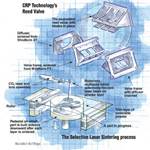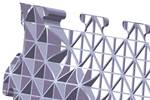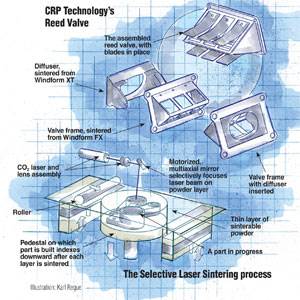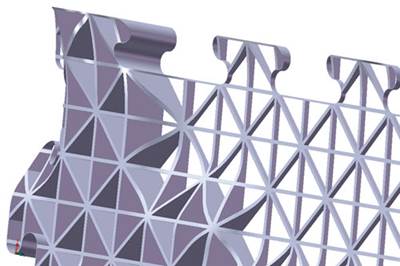Prototyping and manufacturing by additive fabrication
Additive fabrication (AF) technology, such as laser sintering (LS) and fused deposition modeling (FDM), encompasses a wide range of applications. The earliest was rapid prototyping to support design, concept modeling, fit/function testing, and pattern making without the need to construct expensive tooling for prototypes and test articles. Manufacturers also are using AF to produce jigs, fixtures, drill guides, and other manufacturing and assembly tools.
Additive fabrication (AF) technology, such as laser sintering (LS) and fused deposition modeling (FDM), encompasses a wide range of applications. The earliest was rapid prototyping to support design, concept modeling, fit/function testing, and pattern making without the need to construct expensive tooling for prototypes and test articles. Manufacturers also are using AF to produce jigs, fixtures, drill guides, and other manufacturing and assembly tools. And in some cases, AF is used to build the actual production tools for certain parts. Recently, a growing number of organizations are using AF to actually manufacture the products — or parts that go into the products — especially when they are difficult, impossible or too expensive to produce any other way. Many refer to this practice as rapid manufacturing (RM), while others call it direct digital manufacturing (DDM).
Some of the most interesting work and a great areas of opportunity is in the development of new RM materials. A number of composite materials have been produced and used, and others are being developed. EOS GmbH (Electro Optical Systems), a Munich, Germany-based maker of LS machines, offers its PA 3200 GF material, a glass-filled polyamide that withstands high mechanical loads. The company's Alumide product is an aluminum-filled polyamide that works well for wind tunnel testing and can be machined. CarbonMide from EOS is a carbon fiber-filled polyamide with good stiffness and strength. All three materials run in the EOSINT P class machines from EOS.
3D Systems (Rock Hill, S.C.) offers glass-reinforced and metal-filled composite materials for its LS systems. Also, Advanced Laser Materials LLC (Belton, Texas) offers a line of polyamide blends mixed with glass for laser sintering. CRP Technology Srl of Modena, Italy has produced many laser-sintered composite parts for race cars and racing cycles using its Windform materials. Windform XT is a carbon-filled polyamide, and Windform Pro is an aluminum- and glass-filled polyamide used to produce air ducts, shrouds and other pieces that direct the flow of air.
For 3D Systems' stereolithography (SL) machines, a relatively new nanocomposite resin called Accura Greystone is available for applications in the aerospace and automotive sectors. DSM Somos (Elgin, Ill.), a supplier of SL materials, also offers a nanocomposite material for SL. 3D Systems, DSM Somos and Huntsman Advanced Materials (The Woodlands, Texas) offer photopolymers for SL that mimic the physical properties of some thermoplastics, such as ABS and polypropylene.
Stratasys' (Eden Prairie, Minn.) FDM has become the most popular AF technology in annual unit sales. The thermoplastic materials available for FDM are a major factor in its success. Among them are ABS, polycarbonate, ABS/PC, polyphenyl-sulfone, and medical-grade ABS materials that can be sterilized using gamma irradiation.
Less than a year ago, Objet Geometries (Rehovot, Israel) launched the Connex500 3D-printing system that can print two build materials si-multaneously. The system is based on Objet's new PolyJet Matrix printing technology. Objet coined the term Digital Material to describe the result of producing a composite substance using PolyJet Matrix technology. Digital Materials are formulated by simultaneously jetting two materials to create a new composite material. This is an industry first, and we have seen only the tip of the iceberg in terms of what is possible with this technology.
Over the last few years, a number of coatings and treatments have been developed and successfully applied to AF parts. These special treatments improve surface aesthetics, mechanical properties, thermal conductivity, EMC-shielding capability, and electrical conductivity. For example, DSM Somos offers a coating process called Metal Clad Composite (MC2), which combines high-strength resins with nickel-plating technology to achieve significantly enhanced material properties and good aesthetics.
Service bureaus, such as Alphaform AG (Feldkirchen, Germany) and RePliForm Inc. (Baltimore, Md.), continue to offer proprietary metal-coating technologies that significantly enhance the base material, which is usually a plastic AF material. The application of a thin metallic coating can significantly improve the aesthetic and mechanical properties of a part made by additive fabrication.
PAR3 Technology Inc. (Cookeville, Tenn.) offers a post-treatment called RP Tempering. The company offers several versions, including 1) the backfilling of predesigned tunnels in a part using a proprietary, composite material, 2) the application of a spray coating, called Proto-Plasma-Rx, that enhances mechanical and thermal properties and chemical resistance, and 3) the application of a Hi-Temp Protoplass spray that enhances thermal properties, heat resistance and heat deflection. Notably, CRP Technology has announced success in applying PAR3's RP Tempering fire-retardant treatments to its Windform XT material, which is particularly interesting for some aerospace applications.
Charlotte, N.C.-based xlaFORM offers a nonhazardous thermoset resin treatment system that significantly strengthens parts made on the 3D printers from Z Corp. (Burlington, Mass.). The treatment requires special equipment that automates the process. Customers include NASA, Northrop Grumman and 3-D replica manufacturer FigurePrints.
The opportunity to develop new materials, especially composites and metal alloys, is big. The University of Texas at Austin has joined with collaborators at the University of Dayton Research Institute and Texas A&M University to demonstrate the laser sintering of Nylon 11 with carbon nanofiber and intumescent additives. Powder is formulated by extrusion-blending components and cryomilling the product. The research is aimed at improving the flame retardancy of polymers. Several formulations have passed the UV 94 requirement for flame retardancy.
In a similar study, Newcastle University, in collaboration with colleagues at Leeds University, has developed a polymer nanocomposite system based on Nylon 6 and either ceria, yttria-stabilized zirconia, or hectorite clay. Mixing was achieved by dissolving the constituents, mixing and spray drying.
In a third nanocomposite polymer study, researchers at UCLA, Lion Chemtech Co. of South Korea, and the Korea Institutes of Machinery and Materials have joined forces to create Nylon 12 powder with nitric acid oxidation-functionalized graphite nanoplatelets. The composite powder was formulated by rotary mechanical mixing.
Materials for additive fabrication have come a long way since the days of brittle SL resins. Many companies use the latest generation materials routinely for rigorous fit and function test-ing. What's more, a growing number use them to produce end-use parts and products. Even so, additional years of development and testing are expected before AF systems and materials will serve as a solution for mainstream manufacturing.
Note: Parts of this column were excerpted from Wohlers Report 2008, a global study on the advances in additive fabrication.
Related Content
Jeep all-composite roof receivers achieve steel performance at low mass
Ultrashort carbon fiber/PPA replaces steel on rooftop brackets to hold Jeep soft tops, hardtops.
Read MoreImproving carbon fiber SMC simulation for aerospace parts
Simutence and Engenuity demonstrate a virtual process chain enabling evaluation of process-induced fiber orientations for improved structural simulation and failure load prediction of a composite wing rib.
Read MoreTesting to support composite bolted joint analysis
An overview of ASTM Standard Guide D8509, and its coupon-level mechanical testing of design properties for analyzing composite bolted joints.
Read MoreAurora reveals latest SPRINT X-Plane design concept
An Aurora and Boeing team advances its high-speed, vertical lift concept to the preliminary design phase, which features three lift fans, a more refined composite exterior and an uncrewed cockpit.
Read MoreRead Next
Focus on Design: The promise of rapid manufacturing
Selective Laser Sintering technology and new materials abbreviate the design phase and produce a key part for a new motorcycle racing engine.
Read MoreRapid Manufacturing, Part II: Pioneer Applications
Harbingers of what could be a significant trend, these composites manufacturers demonstrate the potential of additive fabrication and several innovative materials in tool-free manufacture of complex components.
Read MoreRapid Manufacturing, Part I: The Technologies
An outgrowth of rapid prototyping, tool-free additive fabrication is shortening product development cycles for manufacturers of smaller, limited-run composite parts.
Read More





.jpg;maxWidth=300;quality=90)













